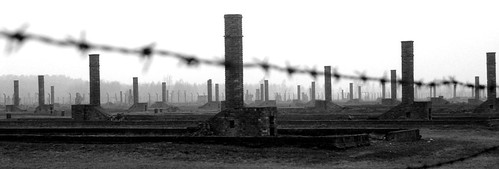From Wikipedia: Auschwitz (German: Konzentrationslager Auschwitz) was a network of concentration and extermination camps built and operated in Polish areas annexed by Nazi Germany during the Second World War. It was the largest of the German concentration camps, consisting of Auschwitz I (the Stammlager or base camp); Auschwitz II-Birkenau (the Vernichtungslager or extermination camp); Auschwitz III-Monowitz, also known as Buna-Monowitz (a labor camp); and 45 satellite camps.
Auschwitz is the German name for Oświęcim, the town in and around which the camps were located; it was renamed by the Germans after they invaded Poland in September 1939. Birkenau, the German translation of Brzezinka (birch tree), refers to a small Polish village nearby that was mostly destroyed by the Germans to make way for the camp.
Auschwitz II-Birkenau was designated by Heinrich Himmler, who was the Reichsführer and Germany's Minister of the Interior, as the place of the "final solution of the Jewish question in Europe". From spring 1942 until the fall of 1944, transport trains delivered Jews to the camp's gas chambers from all over Nazi-occupied Europe. The camp's first commandant, Rudolf Höss, testified after the war at the Nuremberg Trials that up to three million people had died there (2.5 million gassed, and 500,000 from disease and starvation), a figure since revised to 1.1 million, around 90 percent of them Jews. Others deported to Auschwitz included 150,000 Poles, 23,000 Roma and Sinti, 15,000 Soviet prisoners of war, and tens of thousands of people of diverse nationalities. Those not killed in the gas chambers died of starvation, forced labor, lack of disease control, individual executions, and medical experiments.
On January 27, 1945, Auschwitz was liberated by Soviet troops, a day commemorated around the world as International Holocaust Remembrance Day. In 1947, Poland founded a museum on the site of Auschwitz I and II, which by 1994 had seen 22 million visitors—700,000 annually—pass through the iron gates crowned with the infamous motto, Arbeit macht frei ("work makes you free").
Tuesday, 19 April 2011
Chimneys, Auschwitz
Labels:
Auschwitz,
Barbed,
Black and White,
Chimneys,
Concentration Camp,
Oswiecim,
Wire
